Insects, Millipedes and Arachnids
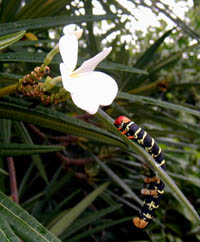 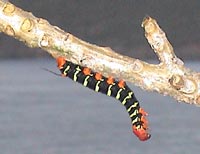 Frangipani Caterpillar
(Pseudosphinx tetrio)
|
At up to six inches in length, the frangipani
caterpillar is an impressive sight.
It's bright coloration warns birds and other
predators that it is not a very tasty meal.
The caterpillar feeds on the frangipani tree,
which produces a poisonous sap.
The caterpillar is not harmed by eating the
sap and it actually makes itself toxic and
foul tasting to predators in the process.
After the caterpillar gorges itself, it drops
and buries beneath the ground to
metamorphosize into a large hawk moth.
 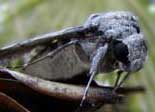 Hawk Moth
(P. tetrio)
|
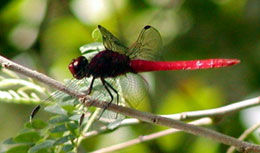 Dragonfly
|
Often brightly colored, dragonflies are commonly found near areas of fresh water, which is necessary for dragonflies to breed. Females typically lay eggs in plant tissue on, near, or below the water.
Some species lay eggs directly into the water.
Aquatic larvae emerge from the eggs and undergo a series of metamorphoses that may last from 3 months to 6 - 10 years (depending on species)
before becoming winged adults.
Dragonflies are strong flying aerial predators that hunt using their exceptional eyesight. They are sometimes called 'mosquito hawks.' Dragonflies can feed on any animal as large as or smaller than themselves. Even small frog tadpoles can become dragonfly prey.
|
Shiny and metallic in color, carpenter bees
construct nests by making tunnels of up to
twelve inches long in decaying logs, tree
stumps, fence posts, or eaves of buildings.
Because of their tunneling, these bees are
often considered pests. However, they are
important pollinators of passion fruit flowers.
Due to their large size (over an inch in length)
these bees often inspire fear, but they are
typically not aggressive and seldom sting.
|
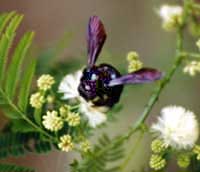 Carpenter Bee
(Xylocopa micans)
|
Termites feed on wood and build large nests of wood pulp on tree trunks and plant stems. They avoid sunlight and construct tunnels of pulp leading from the nest in order to move about while remaining in darkness. Protozoa living in their digestive systems allow the termites to digest their high cellulose diet. Brown-throated conures have been known to build nests in active termite nests.
 Termite Tunnels
|
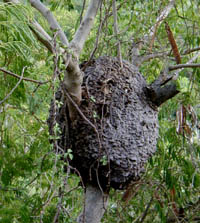 Termite Nest
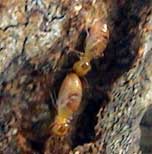 Termites
|
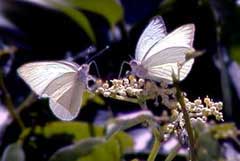 White Sulphurs
|
White sulphurs are common butterflies in the Virgin Islands. They are usually found zipping from flower to flower in sunny areas and are easily recognized by their white color. The butterfly uses a long extendable proboscis to drink nectar from flowers.
As the sulphur feeds, it picks up pollen from one flower, then transfers the pollen to the next flower the butterfly visits.
|
Millipedes are elongated animals with many legs.
They are often found on trees or near rotting wood or damp soil. As a defensive reaction, millipedes can excrete a foul smelling and tasting fluid.
Millipedes feed on plant material, both live and decaying.
|
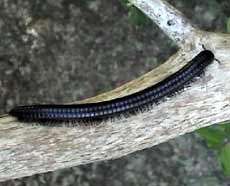 Millipede
|
Worldwide, there are many species of
tarantulas. The Virgin Islands are home
to a species that lives in holes dug in dry
soil. Locally, they are also known as
ground spiders. With their legs spread
out, they can be 4 - 5 inches wide.
While the spiders are rarely seen, their
burrows can be locally abundant.
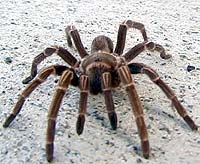 Tarantula (Cyrtopholis bartholomei)
|
The spiders hunt during the night or lunge
onto any small creature unfortunate enough
to enter the lair. They use their fang-like
chelicerae to inject venom into the prey.
Though painful, the bite is not seriously
dangerous to humans.
 Tarantula Burrow
A tarantula can be extracted from its hole
by sticking a tufted-tipped weed into the
burrow and pulling the spider out when it
grasps the end. Although other species of
tarantulas do well as pets, this species
does poorly in captivity and is best left
in the wild.
|
Orb weavers are common spiders in the Virgin Islands and their large and varied webs can be observed on nearly any outdoor excursion.
Different species construct webs of varied design.
Females are typically larger than males and males often spin smaller webs on the edges of the webs of females. The spiders usually feed on insects and other spiders that become entrapped in the sticky webs. However, small tree frogs that become stuck in the webs of large spiders are in danger of becoming a meal as well.
|
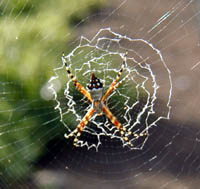 Orb Weaver
|
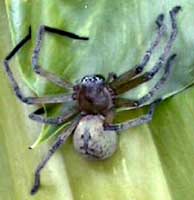 Giant Crab Spider (Olios giganteus)
|
Giant crab spiders are another large spider
species found in the Virgin Islands.
With their legs spread out, these spiders
can reach widths of over 3 inches.
Giant crab spiders have been known to
live for several years. When not hunting or
searching for mates, these spiders spend
their time in tightly woven silk sacs.
Like tarantulas, giant crab spiders can
look very fearsome and have large and
formidable fang-like chelicerae which they
use to inject venom into their prey.
However, their bite is not seriously
dangerous to humans.
|
Relatives of spiders, scorpions are secretive residents of the Virgin Islands. They are active at night and rarely seen. Scorpions use the stinger located at the end of the tail to immobilize prey and for self-defense. Some species do not use the stinger at all and rely on their claw-like pedipalps. Although greatly feared, the sting of most species is about equivalent to a bee sting (still an unpleasant and potentially dangerous experience).
Scorpions fluoresce under ultraviolet light, making it easier to locate them by shining a black light into the holes and crevices in which they hide.
|
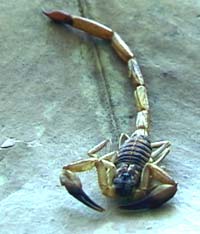 Scorpion (Centruroides gracilis)
|
Encounters with whip scorpions are definitely
memorable experiences. These large relatives
of spiders and scorpions are very flat in profile
and can be over 18 inches across with their legs
spread. Despite their foreboding appearance,
whip scorpions are harmless to humans.
When disturbed, they often quickly dart into
crevices using a sideways crab-like motion.
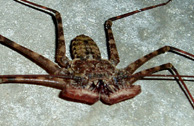 Tailless Whip Scorpion (Phyrnus sp.)
|
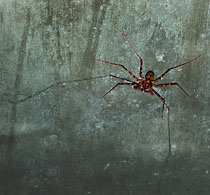 Tailless Whip Scorpion
Active at night, whip scorpions use their
long tactile legs and large claw-like pedipalps to
capture small creatures such as insects,
millipedes and worms. Their diet may
possibly include small frogs and lizards.
The tactile legs act as antennae, both for
navigation and in the detection of prey.
The pedipalps are used to catch and
immobilize the unfortunate prey.
|
